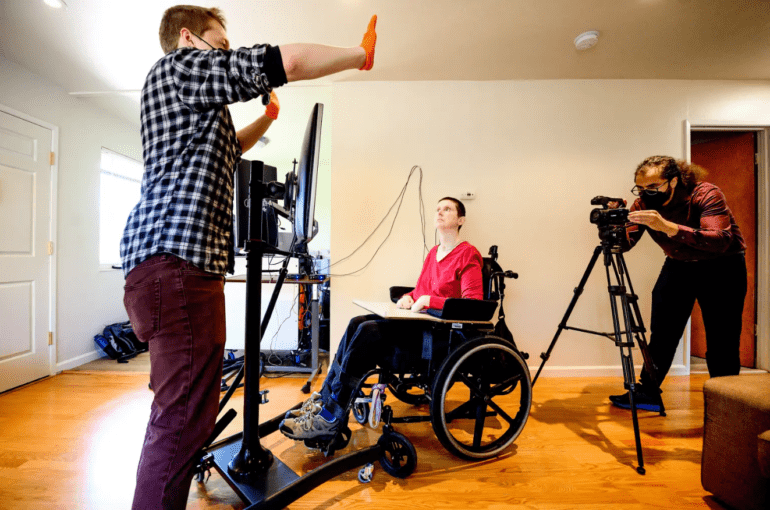TL;DR:
- A woman paralyzed by stroke regains the ability to speak through AI implants.
- Innovative procedure employs 253 brain electrodes connected to computers.
- Brain signals are transformed into speech by AI-generated avatar.
- Avatar mimics expressions, blinks, and voices user’s thoughts.
- Breakthrough marks first-time synthesis of speech and facial expressions from brain signals.
- AI system trained to decode neural patterns for phoneme-based speech.
- Wireless version is in development for a seamless connection.
- Potential impact on patient communication and interaction.
Main AI News:
In a remarkable stride forward, a woman who had been rendered voiceless for years following a debilitating stroke has reclaimed her capacity to communicate, thanks to the marvel of artificial intelligence.
The pioneering procedure hinges on an intricate assemblage of 253 electrodes, meticulously embedded within Ann Johnson’s brain. This intricate network is then seamlessly interfaced with an array of computers through a discreet port that is securely affixed to her cranium.
Situated within the cerebral realm dedicated to processing speech, these electrodes adeptly intercept the intricate nuances of Johnson’s brain signals. With deftness, they transmit these signals to the connected computers, which in turn fashion an on-screen representation – a resolute avatar, a digital simulacrum bearing a striking resemblance to Johnson herself.
Championing personal agency, Johnson handpicked this avatar, endowing it with her thoughts and intentions. Through this digital medium, she can now articulate her ruminations, drawing from a reservoir of speech cultivated over the years. Notably, her avatar mirrors her blink of eyes and an array of facial expressions, encompassing the spectrum of human emotion. This synthesis breathes life into the virtual construct, infusing it with a remarkable semblance of reality.
Dr. Edward Chang, the eminent figure at the helm of neurological surgery at the prestigious University of California, San Francisco, expressed, “Our endeavor is nothing short of a renaissance of identity, seeking to restore the very essence of personhood.“
Johnson’s narrative, one punctuated by her role as a dedicated math teacher and a spirited volleyball and basketball coach, took an unforeseen detour following her paralyzing stroke. Her maternal aspirations were thwarted, and the ability to embrace her own children was tragically denied.
A resolute journey of rehabilitation ensued, punctuated by incremental gains in mobility and expressions. However, the symphony of her voice remained silent, her words buried beneath the weight of her condition. This silence was a reality she endured until the advent of swallowing therapy allowed her to savor finely textured foods.
“We share a love for cupcakes,” Johnson imparted, her voice an embodiment of her regained agency.
Collaborators from the University of California, San Francisco, and the University of California, Berkeley, illuminate the potency of their innovation. For the first time, they have harnessed the symphony of brain signals to orchestrate both speech and facial expressions.
The underpinning of this ingenuity lies in the training of an AI system. Johnson’s cerebral repetitions, a silent refrain of a 1,024-word lexicon, served as the instrumental notes in this training symphony. Each sound she covertly rehearsed was eventually married to a distinctive neural signature, a harmony deciphered by the vigilant AI program.
In a departure from convention, the AI’s prowess lay in its dissection of phonemes, the elemental units of verbal communication. From this dissection, “hello” becomes a quartet of “HH,” “AH,” “L,” and “OW,” exemplifying the intricacies the program navigates.
Cognizant of 39 phonemes, the AI navigates the labyrinth of Johnson’s brain signals, unfurling them into coherent words at an impressive cadence – 80 words per minute, approximately half the tempo of conventional human interaction.
Sean Metzger, the architect behind this decoder from the esteemed Bioengineering Program at UC Berkeley and UCSF, extols the triumvirate attributes of accuracy, celerity, and lexicon. He envisions a future wherein this AI-enabled conduit galvanizes seamless communication akin to organic conversation.
The evolution continues, poised on the precipice of wireless synchronization. This impending iteration obviates the need for physical tethering, signaling an era where neural dialogues can transcend the constraints of cables.
Dr. Chang, a stalwart figure in the realm of brain-computer interfacing, envisions a future wherein speech sprouts forth from neural tapestries. His aspiration is to resurrect a form of communion unmediated by afflictions, recapturing the verve of human connection.
“As our strides surge forward, the prospect of tangible solutions for our patients emerges ever clearer,” Chang concludes, an augury of progress that resonates profoundly.
Conclusion:
The successful integration of AI implants allowing a paralyzed woman to communicate once more signifies a pivotal advancement in the medical and technological landscape. This breakthrough not only restores essential facets of human interaction for individuals with severe physical limitations but also holds the potential to revolutionize the market for assistive technologies. The convergence of neuroscience and AI paves the way for transformative solutions, underlining a promising avenue for innovative applications and enhanced quality of life for those who rely on such groundbreaking interventions.

